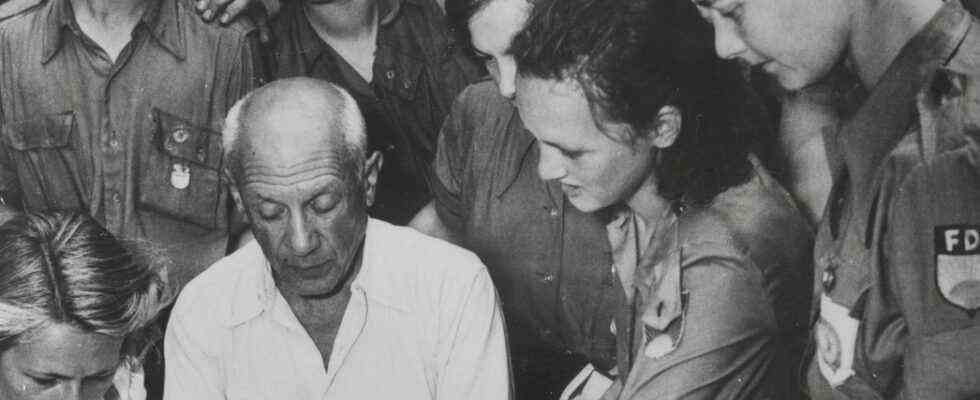Recently appeared an interview with the curator Julia Friedrich in the SZ, which presented a new Picasso exhibition at the Museum Ludwig in Cologne. Next to the text is a historical photo showing Picasso among young peace activists. One of them is Alice Hornung, born in 1934. The Saarland native recognized herself in the picture and talks about how the encounter shaped her fight against war and nuclear weapons. The photo was published on September 1st, anti-war day – a “nice coincidence,” says Hornung.
SZ: Ms. Hornung, as a young peace activist, you were allowed to visit Pablo Picasso in his house near Nice in 1950. How did that happen?
Alice Hornung: That was on the occasion of one of the first European youth peace meetings, Picasso was the patron. The focus was on the campaign for the Stockholm Appeal, which called for the banning of the atomic bomb and for which millions of signatures had been collected worldwide – including from us. A competition was held between the peace activists in Berlin, Rome and Paris to determine who would collect the most signatures. The Berliners won and should be honored at this festival in Nice, but could not make the trip because of the Cold War. I was active in the Free Democratic Youth in Saarland, and since we lived right on the French border, our association was sent to represent. Picasso invited us on site.
How do you remember it?
From the viewer, I am standing on the photo to the right of Picasso: the dark-haired girl, whose hand is on the table. We weren’t art connoisseurs, we were young people who campaigned for peace. All had had war experiences in their families or in their own lives. We were shocked by the aftermath of the atomic bombing on Hiroshima and Nagasaki. Our aim was to do something for peace. Suddenly we were received by the great Picasso whom the whole world adored – an amazing experience.
Alice Hornung, 86, is still active in the peace movement. After the Saar referendum in 1935, her family fled to France to escape the Nazis. Hornung’s father was Jewish. The family lived in exile for ten years.
(Photo: private)
What did Picasso say back then?
He told us how important youth engagement for peace is, just so soon after the war. He particularly emphasized the commitment of German youth, we had an inglorious past. The fact that young Germans of all people had been so actively collecting signatures for the Stockholm appeal was an important sign for Picasso. And he encouraged us to keep going. Only in peace can the youth have a happy future.
What do you still remember?
Picasso asked about our biographies. Our delegation consisted mainly of boys and girls with an anti-fascist past. After the Saar referendum in 1935, my parents had to leave Saarland to avoid the Nazis’ access. My papa was a Jew and active in the socialist working-class youth. We lived in exile in France for ten years. These were things of interest to Picasso.
What was your idea of him before the meeting?
For me he was the creator of the dove of peace and the anti-war painting “Guernica”. He also played an important role in the peace movement.
Was Picasso more of an artist or a peace activist for you?
He was both, but for us primarily a peace activist. You can’t expect a great understanding of art from 15- or 16-year-olds who had only seen war for years. He encouraged us to convince even more people of the idea of peace.
The new exhibition “The Divided Picasso” in Cologne shows that he was presented in a rather apolitical way in West Germany. Has he been misunderstood?
At least he was misrepresented. I cannot judge whether the population has misunderstood him. In Saarland, we were strongly influenced by French. Picasso was worshiped there.
Did the meeting shape your work in the peace movement?
It reaffirmed my commitment. After the Stockholm appeal, we fought against the war in Indochina, against the Korean war, against the rearmament of the Federal Republic. We later demonstrated against the storage of Pershing missiles in Germany. The experience with Picasso was always present, his example gave me and others orientation. Picasso made it clear to us how important it is for everyone to do something.
Do you also take to the streets for peace at the age of 86?
Yes of course. For example, I work in a peace network. On September 1st, we held anti-war campaigns with unions. In Büchel (Air force base in Rhineland-Palatinate, editor’s note. Red.) I am demonstrating against the storage of US atomic bombs. The nuclear problem is not gone. And when I think about the fact that we in the Federal Republic of Germany have a defense budget of almost 50 billion euros, and there are demands to increase it by a further 20 billion euros by 2030, then these insane armaments expenditures scare me! History shows that you cannot solve conflicts with weapons and war.

